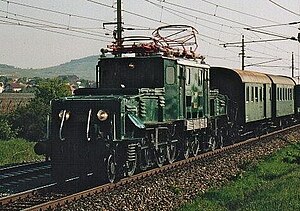BBÖ 1100
| BBÖ 1100 / BBÖ 1100.1 / ÖBB 1089 / ÖBB 1189 | |
|---|---|
|
The 1100.102 at the head of a special train near Gumpoldskirchen
|
|
| Numbering: | BBÖ 1100.01–07 BBÖ 1100.101–109 ÖBB 1089.01–07 (with gap) ÖBB 1189.01–09 |
| Number: | BBÖ 1100: 7 BBÖ 1100.1: 9 ÖBB 1089: 6 ÖBB 1189: 9 |
| Manufacturer: | BBC / Vienna , Floridsdorf |
| Year of construction (s): | 1923-24 / 1926-27 |
| Retirement: | until 1979 |
| Axis formula : | (1'C) (C1 ') |
| Gauge : | 1435 mm ( standard gauge ) |
| Length over buffers: | 20,350 mm / 20,400 mm |
| Total wheelbase: | 17,700 mm |
| Service mass: | 113.6 t / 116 t |
| Friction mass: | 89 t / 91.2 t |
| Wheel set mass : | 14.8 t / 15.2 t |
| Top speed: | 65 km / h / 75 km / h |
| Hourly output : | 1800 kW / 53 km / h / 1900 kW / 55 km / h |
| Continuous output : | 1600 kW / 57 km / h / 1740 kW / 60 km / h |
| Starting tractive effort: | 220 kN / 224 kN |
| Driving wheel diameter: | 1,350 mm |
| Impeller diameter: | 870 mm |
| Motor type: | 1 ~ Rs |
| Power system : | 15 kV / 16 2 ⁄ 3 Hz |
| Number of traction motors: | 4th |
| Drive: | Group drive with additional gear |
| Locomotive brake: | Vacuum brake, later compressed air brake |
| Train brake: | Vacuum brake, later compressed air brake |
The BBÖ 1100 and BBÖ 1100.1 were electric express train locomotives in crocodile design from the interwar period in the service of the Austrian Federal Railways (BBÖ at the time). The first copies were put into service in 1923/24. After Austria was annexed in 1938, the Deutsche Reichsbahn designated them as E 89 (1100) and E 89.1 (1100.1). After the Second World War, the remaining machines came as ÖBB 1089 and ÖBB 1189 to the re-established Austrian Federal Railways (ÖBB), which did not completely decommission them until 1979.
history


For the ramp routes of the Arlbergbahn , the BBÖ needed electrically powered express train locomotives. At the beginning of the 1920s there was still no viable alternative to the rod drive. The decision was made in favor of a design based on the Swiss model, the SBB Ce 6/8 II . The 1100 and 1100.1 series are the only “crocodile” designs in Austria, a designation that comes from the Märklin company in the toy train sector. In contrast to the original, a somewhat simpler drive with a single drive rod was chosen, which connected both the jackshaft and the drive wheels. To avoid confusion: Of course there were four such connecting rods.
The first seven machines were delivered by Brown Boveri & Cie (electrical part) and by Lokomotivfabrik Floridsdorf (mechanical part) in 1923/24. In 1926/27 another nine locomotives followed, which were stronger and slightly heavier than the first delivery (see table). The first seven vehicles delivered were given the series designation 1100, the last nine 1100.1. They were initially stationed in Innsbruck , later also in Salzburg , from where they were used to full satisfaction on the Arlberg and Tauern railways . On the valley lines they were replaced by locomotives of the 1670 series .
The German Reichsbahn described it after the annexation of Austria in 1938 as the E 89 (1100) and as E 89.1 (1100.1).
In World War II, two former 1100s were destroyed. One of them, the 1100.01, was rebuilt by the ÖBB , which assigned the series numbers 1089 and 1189 to the vehicles in 1953 , and used in its intended role for over twenty years.
By 1979 the machines were completely decommissioned, which also contributed to the fact that the lubrication of the drive made a second man necessary to manage the machines.
Preserved machines

The 1189.02 has been preserved to this day and is used to cover nostalgic trains. It currently bears its original number 1100.102 and was also the only locomotive in its series that was painted blood orange in the 1970s. 1089.06 is in the Auto- und Technikmuseum Sinsheim , the 1189.05 in the Railway Museum Strasshof . 1189.09 has stood in front of the customs building as a motorless monument since the opening of the freight yard (1983) in Wolfurt . The municipality of Wolfurt has given this locomotive to the ÖGEG for the Railway and Mining Museum in Ampflwang as a permanent loan .
literature
- B. van Nes: The first electric mountain express train locomotive of the Austrian Federal Railways . Vienna, Selbstvlg d. Austrian Brown-Boveri-Werke 1923
- Roland Alber: The electric locomotive 1100.102. Addition to the museum edition of the locomotive.
- Helmut Griebl: Austria's crocodile. The 1100 / E89 / 1089 series. Railway picture archive Volume 11, EK-Verlag, Freiburg im Breisgau 2005, ISBN 3-88255-350-2 .
- Markus Inderst : Picture atlas of the ÖBB locomotives. All traction vehicles of the Austrian Federal Railways. GeraMond, Munich 2010, ISBN 978-3-7654-7084-4 .
- Richard Rotter, Helmut Petrovitsch: Locomotives of Austrian railways - electric locomotives and railcars. alba Verlag, Düsseldorf 1990, ISBN 3-87094-132-4 .
- Franz Gemeinböck, Markus Inderst: The series 1089 and 1189. Kiruba-Verlag, Mittelstetten 2017, ISBN 978-3-945631-03-4 .
See also
- other crocodile electric locomotives
